TC Smout Lecture Series
In 2013, Professor Roger Mason, the founder of the Institute of Scottish Historical Research (ISHR), launched the T.C. Smout Lecture in Scottish History to celebrate the eightieth birthday of Professor T.C. Smout, Historiographer Royal in Scotland and patron of ISHR.
November 2023
10th Annual Smout Lecture
‘Scottish independence and British identity:a medieval perspective’
Professor Dauvit Broun
University of Glasgow
In today’s discourse Scottish independence is typically seen as incompatible with British identity. In the late Middle Ages Scotland’s sovereignty was celebrated in histories written in Latin, most notably by Fordun and Bower. It seems surprising, therefore, to find statements in Fordun and Bower’s works where the Scottish kingdom is seen in overtly British terms. This British dimension of medieval Scottish history writing will be examined in this lecture, discussing not only Fordun and Bower, but a recently discovered codex datable to the early sixteenth century.
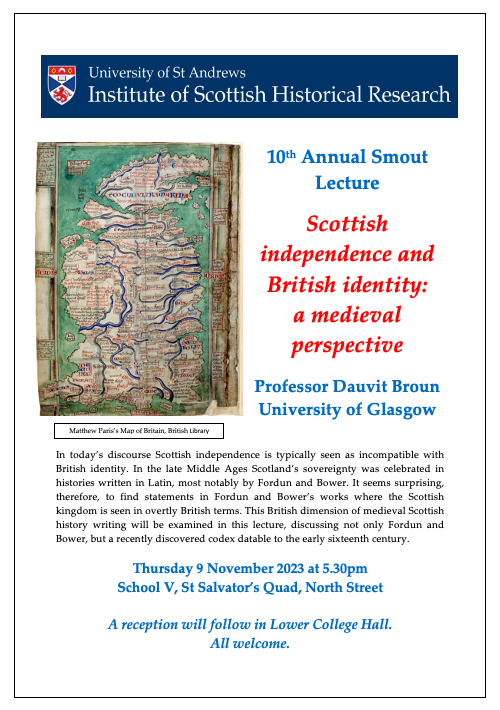
October 2022
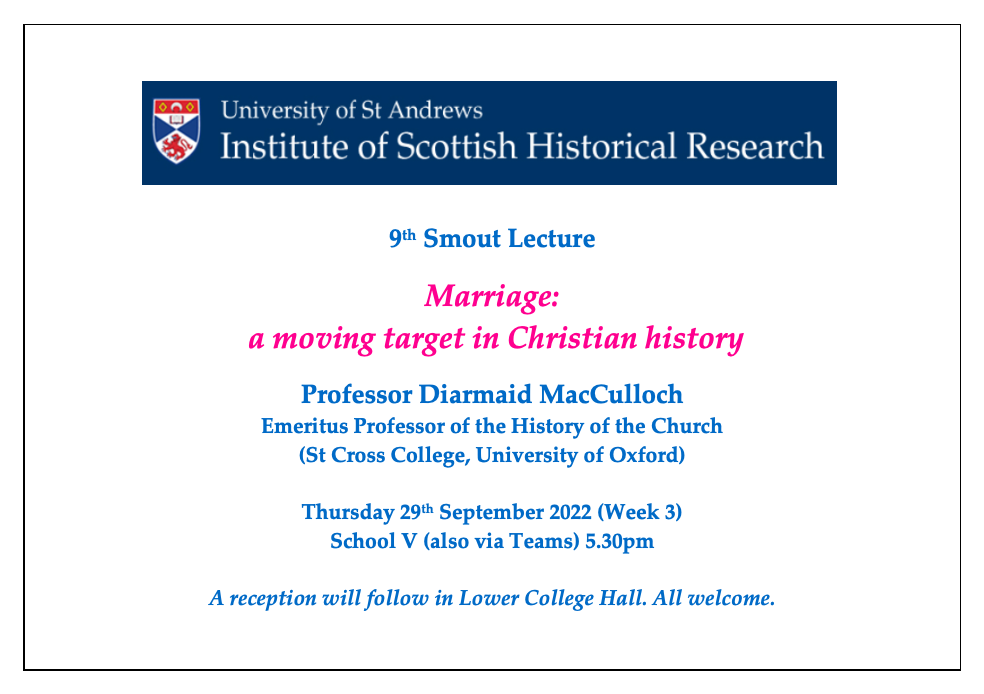
May 2022
*Please note change of venue to Parliament Hall*
Professor Robert Morris (University of Edinburgh)
‘Why does Edinburgh have historic buildings?’
Parliament Hall and Teams, Thursday 5 May, 5.30pm
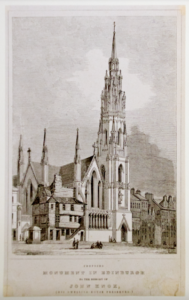
On the 26 July 1849, the Dean of Guild of Edinburgh ordered the demolition of John Knox House – a sensible move. The neighbouring tenement had fallen in the street a few years before. This was one of 156 such orders issued between 1836 and 1852. Remarkable was the enormous stooshie which followed, involving: the Free Church; the Society of Antiquaries; the leading dissenting churches; the anti-slavery movement; and the Court of Session. By the 1850s the new heroes of urban built culture were not the makers of the much derided ‘New Town’ with its boring uninspiring straight lines and oblong windows, but those who remade an imagined historical landscape. What did they think they were doing? There was John Knox House where, as far as we know, John Knox never lived. There was a splendid Castle of no military value largely created in the later 19th century and that great mystery, a Presbyterian Cathedral. First Task is to follow the money. The great leaders of the printer publishing industry of Edinburgh took the Castle and St Giles as their retirement projects. Railway money and female energy came to White Horse Close and the Free Church invoked their formidable funding raising ability for John Knox. There was a supporting cast of civil society and state agencies. What they did was create places for storytelling, increasingly this was the story of Scotland, many Scotlands in fact. They created a charisma of place which still exists. Pause where Knox preached and prayed or where Argyle spent his last night before execution. Authenticity was important. Here was the bequest of the later 19th century imagined with all its meanings for the 20th and 21st century to puzzle over.
RJ Morris spent all his tax paying life in Scotland and remains Professor Emeritus, having taught economic and social history for many years at Edinburgh University. He has written widely on the middle classes, urban development and associational culture. His publications include: Men, Women and Property in England, 1780-1870, Scotland 1907; The Many Scotlands of Valentine and Sons, Photographers; Politics, Economy and Society; ‘Reading the riot commission: Belfast 1857, Irish Historical Studies, 2019; ‘New Spaces for Scotland, 1800 to 1900’, in Griffiths and Morton (eds), A History of Everyday Life in Scotland, 1800-1900; and ‘Urban Ulster’ in Kennedy and Ollerenshaw, Ulster since 1600. His writing involves civil and uncivil society in Edinburgh and Belfast, together with a focus on the ‘historic’ buildings of the Royal Mile, notably the Castle and John Knox House and what happened to them in the 19th century. He was editor of the Book of the Old Edinburgh Club and President of the European Association of Urban Historians, 2000-2002. Currently, he is President of the Economic and Social History Society of Scotland and patron of the Thoresby Society of Leeds.
2019
Professor Poul Holm (Trinity College Dublin)
‘The North Atlantic Fish Revolution, c.1500 AD: Climate, Markets, People’
New Arts Lecture Theatre, Thursday 3 October, 5.30pm

In 1497, John Cabot returned to Bristol and told of waters off Newfoundland so “full of
fish that [they] can be taken not only with nets but with fishing-baskets”. Within a
few decades, the discovery led to a dramatic increase in supplies of cod (Gadus morhua) to the European market. The ‘Fish Revolution’ permanently changed human and animal life in the North Atlantic region. Not only the seafood market but Atlantic geopolitics were transformed in the process. In this talk, Professor Holm will consider three questions:
(1) What were the environmental parameters of the Fish Revolution?
(2) What were the globalising effects of the Fish Revolution?
(3) What were the consequences of the Fish Revolution for fishing
communities?
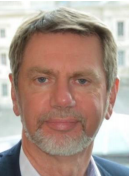
Professor Paul Holm is the Director of the Trinity Centre for Environmental Humanities at Trinity College Dublin. He is also a member of the Royal Irish Academy’s Standing Committee for Archaeology, and Vice-Chair of the Humanities class of Academia Europea. Professor Holm’s research focusses on North Atlantic fisheries c.1400-1700, and more generally the interdisciplinary combination of marine science and history.
This lecture is open to the public and will be followed by a wine reception.
2018
‘Geographies of the Prime Meridian: Ruling the World – from St Andrews, Paris, Washington…’
The Prime Meridian is the point at which the world’s longitude is set at 0 – the calculative origin for measurement of the world’s time and space. Since 1884, we have had only one Prime Meridian, at the Royal Observatory, Greenwich. Before then – but also for a long time afterwards – numerous different prime meridians were at work in the world. Astronomers used different observed prime meridians from the measured prime meridians employed by geographers; navigators might use one, several or none in determining their position on the high seas. Different countries used more than one: eighteenth-century France had two – Ferro in the Canaries, and Paris; the United States continued to use two (Washington and Greenwich) for decades after 1884. The result, world-wide, as one eighteenth-century commentator put it, was ‘geographical confusion’. This richly-illustrated lecture examines why and where different prime meridians were employed and to what end: it is a story of the history and geography of science, of competing forms of measurement, of personal animus, national rivalry and international geopolitics.

Professor Charles Withers is Ogilvie Chair in Geography at the University of Edinburgh and Geographer Royal for Scotland. He was educated at the Universities of St Andrews and Cambridge and has been at Edinburgh since 1994. His research interests focus on the historical geographies of science; exploration, instrumentation and publication; the geography of the Enlightenment; and the history of cartography. His books include Geography, Science and National Identity: Scotland since 1520 (Cambridge 2001); Placing the Enlightenment: Thinking Geographically about the Age of Reason (Chicago 2007); Travels into Print (Chicago 2015), Zero Degrees (Harvard, 2017) and, in more popular vein, Scotland: Mapping the Nation (2011) and Scotland: Mapping the Islands (2016) (co-authored with Chris Fleet and Margaret Wilkes).
The lecture is open to the public and will be followed by a wine reception.
2017
‘The Scotching of British History in the Nineteenth Century, or how a Scot (con)founded the Royal Historical Society’
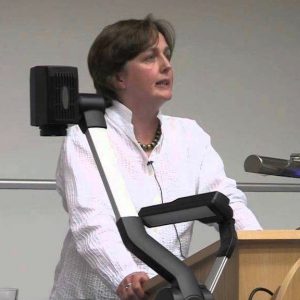
The speaker for the fifth annual TC Smout lecture is Dr Catriona MacDonald, Reader in Late Modern Scottish History and Co-director of the Centre for Scottish and Celtic Studies at the University of Glasgow, is a former editor of the Scottish Historical Review and one of the leading historians of modern Scotland. She is the author of a number of acclaimed books on the social and political history of nineteenth and twentieth century Scotland, including the Saltire Scottish History Book of the year (2010), Whaur Extremes Meet. Her recent publications address both Scottish literature and historiography, and she is currently working on a monograph on the history of Scottish history since 1832.
In her lecture, Dr MacDonald focuses on the life and controversial career of Scotsman (and son of the manse of Dunino in Fife), Charles Rogers (1825-1890), the principal founder of the Royal Historical Society. She identifies the roots of the Society in the traditions of Scottish associational culture and examines the consequences of Rogers’ ultimate debacle for the future character of British History and its institutions. In so doing, she raises important questions about the intellectual limits of Unionist nationalism, the commercial opportunities borne of a new popular print culture, and the long shadows cast by reputation over Victorian Scottish men of letters.
The Deputy Principal, Prof Gary Taylor, will take the chair. The lecture is open to the public and will be followed by a wine reception.
2016
Sir George Mackenzie and The Stuarts
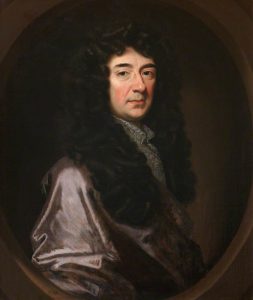
The fourth annual TC Smout lecture was delivered by Dr Clare Jackson, Senior Tutor, Trinity Hall, University of Cambridge, at the University of St Andrews, 29 September 2016, at 5:30 pm. The lecture took place in the Arts Lecture Theatre, followed by a wine reception in the foyer.
Sir George Mackenzie of Rosehaugh (c.1636-91) would have been an energetic – if partisan – predecessor to Professor Christopher Smout as Historiographer Royal of Scotland. Popularly caricatured as ‘Bluidy Mackenzie’ in Covenanting legend, Mackenzie’s staunch defence of the Stuart dynasty underpinned his political theorising, histories of the Scottish nation and jurisprudential writings. But as this lecture illustrates, Mackenzie’s own relationship with his actual Stuart masters was more complex, and twice led to his relinquishing his post as King’s Advocate on grounds of conscience. Fearing assassination for his actions on the Stuart kings’ behalf, Mackenzie left Scotland in 1689, ruefully acknowledging that ‘My bigotry for the royal family and monarchy is and has been very troublesome to me.’

Dr Jackson has a particular interest in the politics of multiple monarchy in 17th-century Britain; her most recent publication is Charles II (2016) in the Penguin Monarchs series. She is also the author of Restoration Scotland, 1660-1690: Royalist politics, religion and ideas (2003), and over twenty articles on aspects of early modern British history. She has been a regular contributor to BBC Radio 4’s In our Time, and presented a three-part television series on The Stuarts for BBC2 in 2014, followed by a sequel, The Stuarts in Exile (2015).
2015
The annual T. C. Smout lecture in Scottish History was delivered by Prof Sir Tom Devine on Thursday 8 October at 7pm in the Arts Lecture Theatre. Entitled ‘Scotland and Slavery: Amnesia and Denial,’ the lecture endeavored to resolve a historical puzzle:
The international Scotland and Slavery Project reveals in great detail the full extent of the nation’s involvement at all levels of the Atlantic slave systems between the mid seventeenth and early nineteenth centuries (the results are published in T. M. Devine (ed.), Recovering Scotland’s Slavery Past (Edinburgh University Press, 2015)). Yet until the last decade or so Scottish academic history, creative literature and public discourse were virtually silent on this controversial subject. When it was occasionally broached, the assumption was that Scots had little to do with chattel slavery. That nefarious business was essentially seen to be the preserve and monopoly of the English, and especially of the ports of Bristol, Liverpool and London. This lecture will seek explanations for amnesia and denial over the long run from the end of slavery in the British empire in 1833 to the new research of more recent times which has served to demolish the old mythologies.
Professor Sir Tom Devine is Sir William Fraser Professor Emeritus of Scottish History and Palaeography in the University of Edinburgh. He previously held Chairs in Scottish History and Irish-Scottish Studies at Strathclyde and Aberdeen Universities respectively. He is a Fellow of the Royal Society of Edinburgh, Honorary Member of the Royal Irish Academy and Fellow of the British Academy. He has been awarded several prizes and honorary degrees throughout his career, notably the Royal Gold Medal, Scotland’s supreme academic accolade, by HM The Queen on the recommendation of the Royal Society of Edinburgh. His next book will be Independence or Union: Scotland’s Past and Scotland’s Present to be published by Allen Lane: The Penguin Press in April 2016. Tom Devine was knighted in 2014 ‘for services to the study of Scottish history’.
2014
The 2014 T.C. Smout Lecture in Scottish History was delivered by Professor Christopher A. Whatley on ‘“Burns by an Englishman is impossible”: sculptors, statues and the contested memory of Robert Burns.’
Britain, it has been said, went ‘statue mad’ in the Victorian and Edwardian eras. In Scotland (and North America) numerous statues of Robert Burns were erected. Professor Whatley’s lecture explored the reasons for the surge of enthusiasm for permanent memorials of a poet who had died in 1796. What was also be revealed were the personal, ideological, and aesthetic tensions that characterized many of the statue building projects, and the furious – and frank – debates that followed as towns and sculptors vied with other to erect a fitting monument to the ‘Poet of the Scotch’ during a period of political reform, urban improvement and intensifying Scottish national sentiment.
Professor Whatley is Emeritus Professor in Scottish History at the University of Dundee, where until recently he was Vice-Principal. He is a Fellow of the Royal Society of Edinburgh and author of an acclaimed series of books and articles on modern Scottish history, notably Scottish Society, 1707-1830 : Beyond Jacobitism, Towards Industrialization (2000) and The Scots and the Union (2006; revd edn 2014).
2013
The inaugural lecture was presented by Professor Fredrik Jonsson of the University of Chicago on “Enlightenment’s Frontier: the Scottish Highlands and the Origins of Environmentalism.” The University Principal, Prof. Louise Richardson, took the chair. At the end of the lecture Prof. Smout gave an address.